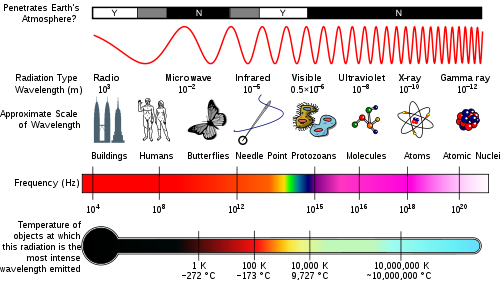What are the flavors of light?

Panorama of ATA site
April 30, 2012
can’t hug orphans
May 8, 2012There are good reasons that almost everything we know about the distant universe came to us through measurements of light (electromagnetic radiation). Since light was present even at the birth of the universe, the field of astronomy predates just about everything. From another perspective, astronomy began when the first creatures looked up from the surface of their planet and asked, where does that light come from?
Since light is so important to astronomy, we should study the limits of light in every possible dimension, from extreme to extreme. There are four dimensions along which light may vary, but we don’t often give much thought to more than one or two. Here I take a moment to outline all the different ways light can exhibit itself.
The first dimension is color, or to physicists, frequency. The image at top describes only the frequency dimension of light. Those things we call radio waves, x-rays, gamma-rays, are all the same thing as light, with different frequencies. To physicists, the difference between what we call everyday light and x-rays (higher frequency) or cosmic microwave background radiation from the big bang (ironically low frequency) light is merely a constant and has no effect on the physics.
Today’s astronomy picture of the day shows us two more dimensions which are used to describe light. From the perspective where our telescope is the center of the universe, we speak of the direction of arrival of light. The direction of arrival is specified with two angles (in astronomy, right ascension, declination) but in human experience we normally approximate these angles as spatial coordinates (up/down, left/right):

- Astronomy Picture of the Day, May 3, 2012, Close to the Great Bear (Ursa Major)
With the two dimensions of this display, and the dimension of color, that’s all there is, right? In truth, there is one more dimension, which we call polarization. Interestingly, evolution has not given our eyes sensitivity to polarization but it is an important physical property of radiation.
To understand polarization, lets go back to the basics. Light is electromagnetic radiation, and our eyes respond to oscillations of the electric field. But the electric field is a vector field, meaning it has a direction. No matter how complicated the light may become, standing outside your door or at the center of the sun, the electric field vector points in only one direction at a time at any point in space. For reasons I won’t mention, light always moves in a direction perpendicular to the direction of the electric field vector, so if light is to move into your eye (or telescope) the electric field vector must be pointing either in the up/down direction or left/right direction as it passes through. These two axes are the two axes of polarization (left/right, horizontal) and (up/down, vertical).
It is easy to see the effects of polarization with polarized sunglasses. Those kind of sunglasses work really well, especially when driving. This is because the light reflected off the hood of your car tends to be polarized in the horizontal direction, so by filtering out horizontally polarized light, you reduce “glare.” The image below shows how a polarized lenses can alter your view of the world, proving the difference between information carried in two polarizations of light:

Polarized Lenses Remove Glare
When we do SETI, we need to think about all four of these dimensions which can be used to describe the radiation that comes to us from the sky. In future blogs, I intend to explore these dimensions in more detail and explore all the different ways nature, and ET, can send us information using light.


5 Comments
really it did have something for me …….thanks for the wonderfull info Mr gharp.
as always an excellent posting. the way you write is awesome. thanks. adding more information will be more useful.http://www.planodesaudephs.com
Thanks for the positive feedback. Maybe I should write some more?
What is the radiation type wavelength 10(-14)?
That would still be a gamma ray. It is OK to call anything with higher energy than on the chart a gamma ray.
Note that a proton is 10^(15) meters in diameter, so we can guess that nuclear reactions could create such gamma rays. High energy colliders (like LHC) go down in wavelength even further. There is no lower limit on wavelength but at some point, the light will become impossible to generate without a substantial fraction of the energy in the universe. So we’re not likely to see many of those.
This posting has a very nice graphic, although it is labelled in frequency instead of wavelenth:
http://www.circlon-theory.com/HTML/joules.html